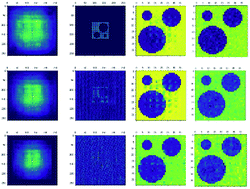当前位置:
X-MOL 学术
›
J. Anal. At. Spectrom.
›
论文详情
Our official English website, www.x-mol.net, welcomes your feedback! (Note: you will need to create a separate account there.)
On the way to full-field X-ray fluorescence spectroscopy imaging with coded apertures
Journal of Analytical Atomic Spectrometry ( IF 3.4 ) Pub Date : 2019/11/27 , DOI: 10.1039/c9ja00232d Anicó Kulow 1, 2, 3, 4, 5 , Ana Guilherme Buzanich 1, 2, 3 , Uwe Reinholz 1, 2, 3 , Christina Streli 4, 5, 6 , Martin Radtke 1, 2, 3
Journal of Analytical Atomic Spectrometry ( IF 3.4 ) Pub Date : 2019/11/27 , DOI: 10.1039/c9ja00232d Anicó Kulow 1, 2, 3, 4, 5 , Ana Guilherme Buzanich 1, 2, 3 , Uwe Reinholz 1, 2, 3 , Christina Streli 4, 5, 6 , Martin Radtke 1, 2, 3
Affiliation

|
Imaging with X-rays is a challenging field, due to the optical properties of X-rays. The fabrication of appropriate optics is usually expensive and requires an elaborate manufacturing process. One simpler and less expensive possibility of imaging high energy radiation is coded aperture imaging, a technique well established in astrophysics and also used in nuclear medicine or radiation detection, e.g., for nuclear decommissioning. Our aim is to adapt coded aperture imaging for X-ray fluorescence spectroscopy in the nearfield. In this work we show theoretical considerations and preliminary simulations of image formation through a coded aperture and three different reconstruction methods to prepare the experiments. We used a new mask based on an inverted modified uniformly redundant array (MURA) that could be used for the construction of a decoding mask for all investigated geometrical arrangements. The most commonly used reconstruction method, convoluting the detected image with a decoding mask, does not always deliver satisfactory results. This is more noticeable for small distances between the object, mask and detector. Hence, we developed two new reconstruction methods, one based on iterative algebraic optimization and another one based on a genetic algorithm. Both show good performance even in those cases where the convolution method fails. This provides a basis for further investigations of the ideal parameters for near field coded aperture imaging and refinements of the algorithms. We performed first measurements with a coded aperture at the BAMline at BESSY II and could successfully reconstruct a test object from the obtained recorded images.
中文翻译:

带编码孔径的全场X射线荧光光谱成像的途中
由于X射线的光学特性,用X射线成像是一个具有挑战性的领域。合适的光学器件的制造通常很昂贵,并且需要复杂的制造过程。对高能辐射成像的一种更简单且更便宜的可能性是编码孔径成像,它是天体物理学中公认的技术,也用于核医学或辐射检测,例如,用于核退役。我们的目标是使编码孔径成像适用于近场的X射线荧光光谱。在这项工作中,我们展示了通过编码孔径和三种不同的重建方法来准备实验的理论考虑和图像形成的初步模拟。我们使用了基于反向修改的均匀冗余阵列(MURA)的新蒙版,该蒙版可用于构造所有研究的几何排列的解码蒙版。最常用的重建方法是用解码蒙版对检测到的图像进行卷积,但并不总是能提供令人满意的结果。对于物体,遮罩和检测器之间的小距离,这一点更明显。因此,我们开发了两种新的重建方法,一个基于迭代代数优化,另一个基于遗传算法。即使在卷积方法失败的情况下,两者仍显示出良好的性能。这为进一步研究近场编码孔径成像的理想参数和改进算法提供了基础。我们在BESSY II的BAMline用编码孔径进行了首次测量,并可以从获得的记录图像中成功重建测试对象。
更新日期:2020-02-13
中文翻译:

带编码孔径的全场X射线荧光光谱成像的途中
由于X射线的光学特性,用X射线成像是一个具有挑战性的领域。合适的光学器件的制造通常很昂贵,并且需要复杂的制造过程。对高能辐射成像的一种更简单且更便宜的可能性是编码孔径成像,它是天体物理学中公认的技术,也用于核医学或辐射检测,例如,用于核退役。我们的目标是使编码孔径成像适用于近场的X射线荧光光谱。在这项工作中,我们展示了通过编码孔径和三种不同的重建方法来准备实验的理论考虑和图像形成的初步模拟。我们使用了基于反向修改的均匀冗余阵列(MURA)的新蒙版,该蒙版可用于构造所有研究的几何排列的解码蒙版。最常用的重建方法是用解码蒙版对检测到的图像进行卷积,但并不总是能提供令人满意的结果。对于物体,遮罩和检测器之间的小距离,这一点更明显。因此,我们开发了两种新的重建方法,一个基于迭代代数优化,另一个基于遗传算法。即使在卷积方法失败的情况下,两者仍显示出良好的性能。这为进一步研究近场编码孔径成像的理想参数和改进算法提供了基础。我们在BESSY II的BAMline用编码孔径进行了首次测量,并可以从获得的记录图像中成功重建测试对象。



























 京公网安备 11010802027423号
京公网安备 11010802027423号